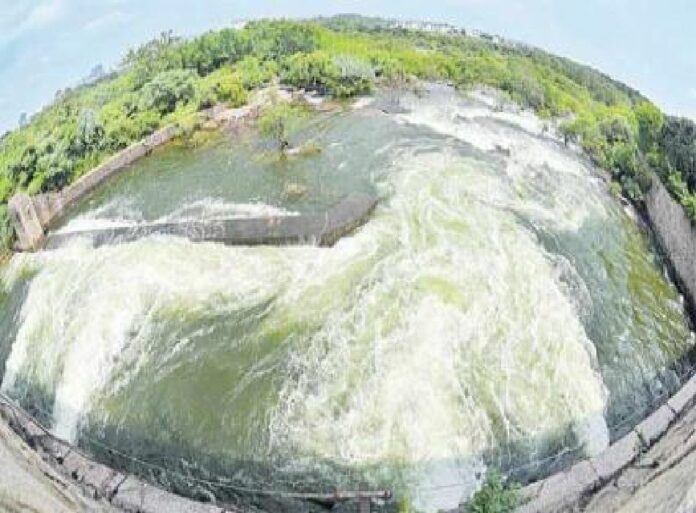As the GO-111, termed ‘redundant’ by KCR was brought in by the then Telugu Desam Party government led by N Chandrababu Naidu in 1996 to restrict major constructions within a 10-km radius of the full-tank level of the two reservoirs HimayatSagar and OsmanSagar in Hyderabad.
A ‘death knell’ for the two historical reservoirs of Hyderabad that served for decades as its primary source of drinking water is what environmental activists call Chief Minister K Chandrasekhar Rao’s latest statement from the floor of the Assembly rescinding Government Order (GO)- 111. They believe it would unleash uncontrolled urbanization, destroying the water-bodies.
The two reservoirs — Osmansagar and Himayatsagar – were commissioned in 1920 by the seventh Nizam of Hyderabad, Nawab Mir Osman Ali Khan, after massive floods ravaged the banks of river Musi in 1908, primarily as a flood-mitigation mechanism. The water from rivers Musa and Isa stored in the reservoirs also provided for a drinking water source for the city.
The GO-111, termed ‘redundant’ by KCR on Tuesday, was brought in by the then Telugu Desam Party government led by N Chandrababu Naidu in 1996 to restrict major constructions within a 10-km radius of the full-tank level of the two reservoirs. Such a buffer zone was necessary to stop any polluting activity, be it a factory or a residential colony or any other establishment, from being set up in the catchment area as well as upstream.
Rao justified himself by adding that Hyderabad no longer depended on these reservoirs for its water requirements. With the government able to draw drinking water from rivers Krishna and Godavari, Rao believed drinking water needs of ever-expanding Hyderabad would be taken care of for the next 100 years.
Not a first time
Applicable to about 1.32 lakh acre of land on the lake’s catchment area, the GO-111 covers 84 villages in Chevella, Moinabad, Shabad, Shamsabad, Rajendranagar and Shankarpally Mandals.
It was not the first time that the CM has talked about scrapping GO-111. In the run-up to Assembly elections in 2018, KCR had promised during a public meeting at Chevella to take back the GO within six months of his party’s return to power.
There has been a demand from villagers, realtors, and public representatives of these localities for scrapping the GO and to allow them to reap the benefits of a real-estate boom that is visible in the nearby IT corridor. They have cried foul at the lack of any development and infrastructure in their villages despite being close to the city. Rao had called this GO a curse on the people of these villages.
However, the CM told the Assembly on Tuesday that he was aware that sudden scrapping of the GO would lead to anarchy and that his government was looking at a measured approach. “The MAUD department will conduct a study to ensure that master plans and green zones are demarcated before the GO is scrapped. An expert committee is looking into the matter and as soon as we receive the report, we will rescind the GO,” he said.
Two reservoirs not redundant
According to a senior environmentalist, Prof K Purushotham Reddy, the government may choose to call the two reservoirs redundant from the point of view of drinking water but it was ‘foolish’ to ignore the core purpose behind the construction of these reservoirs. “We faced urban floods twice in the last three years. When the incidence of urban flooding is on the rise, the core purpose of the reservoirs remains valid. There is no argument there,” he said.
Responding to CM’s statement that the city does not require water from the two reservoirs, senior hydrologist BV Subba Rao wondered how long could the state hope to depend on river-water sources that have catchments across multiple states.
“These two reservoirs are zero-energy water-supply systems that work on gravity. They are cent percent in line with climate adaptation and must be showcased as role models. Unlike many new reservoirs, there is hardly any expenditure incurred here to bring water to the city,” said Subba Rao.
GO-111 needs to be strengthened, not diluted
At present, drinking water for Hyderabad is drawn from the river Godavari at Sripada Yellampalli Project in Mancherial district and from river Krishna at Akkampally Balancing Reservoir in Nalgonda district. According to Subba Rao, the government order needs to be studied comprehensively to meet the needs and relevance of contemporary challenges instead of diluting them.
“Can the local farmers be deprived of their economic growth? No. So we need to study how environmental services of the water-bodies can be linked to a farmer’s economic growth, and what kind of alternate developmental systems can be given to farmers in the form of packages and incentives for greening the development,” said Subba Rao, who is currently working with the Bureau of Indian Standards as a technical member – reservoirs and lakes, water domain.
Noting that the story of Hyderabad is that of vanishing lakes and water tanks, Purushotham Reddy called for increasing the spread of the lake bed in the interest of future generations. “The latest IPCC reports are clear that India will have to pay a heavy price of climate change. Even inland cities like Hyderabad are endangered. Not only these two lakes, but all water-bodies need to be protected from ongoing concretization of the city,” he added.
‘Violation’ of SC order
Moreover, Purushotham Reddy wondered how the state government decided to challenge a judgment of the Supreme Court. “In 2000, the SC had passed a landmark order upholding GO-111 to prevent any contamination of the water-bodies. The CM’s statement is to appease the real-estate lobby. There is no question of revisiting the SC judgment when the matter was settled for once.” Reddy stated. Thakur Rajkumar Singh, an activist associated with Save Our Urban Lakes (SOUL), recalled that three SC-appointed committees in 1999 had recommended the continuation of GO-111 to protect the reservoirs.
Citing violation of GO-111, Singh had in 2016 approached the National Green Tribunal (NGT), following which the collector of Rangareddy district had informed the Tribunal of having identified 12,500 illegal constructions and 400 illegal layouts along with details of owners and their survey numbers.
Subsequently, the state government constituted an expert committee in December 2016 to look into the relevance of GO-111. Even as the government failed to submit the report, the NGT in 2019 ordered the status quo to be maintained in areas under GO-111. “On what grounds does the government plan to dilute GO-111? The CM’s open statement, even as an expert committee’s report is awaited, is a direct effort to influence the outcome of the report. We will challenge this in the Court,” said Singh, adding that he was concerned for the lives of lakhs of people living on the banks of river Musi.
Stressing that the government was underestimating the intelligence of its people, Purushotham Reddy added: “The young and educated people of Hyderabad are vigilant and watching. Any attempt to cancel the GO-111 won’t withstand.” #KhabarLive #hydnews







